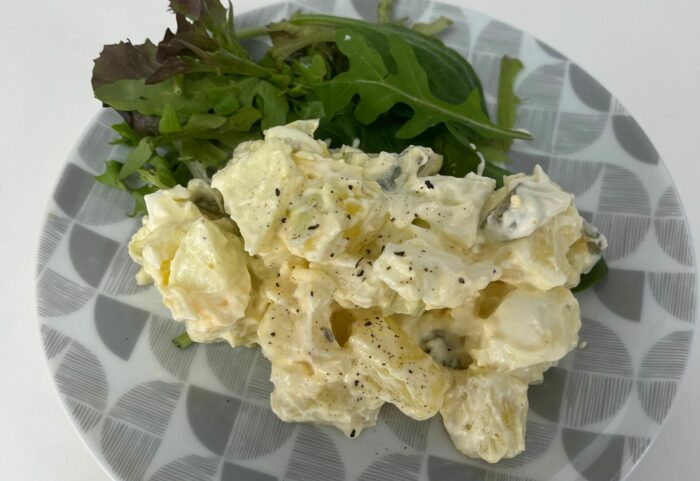This Icelandic Potato salad is very unique as it contains apples but makes a delicious and filling dish that is perfect as a side. Potatoes became a staple food in Iceland because they’re easy to grow and store!
Skills Check
Follow a recipe; follow food safety & hygiene rules; tidy away; use measuring spoons and cups; cut using the bridge/claw technique; season to taste; garnish.
Equipment
Bowl, table knife, chopping board, measuring spoons, spoon, peeler, saucepan.
Allergens*
Egg | Milk | Sulphites
May contain: Gluten | Mustard
* Please note the allergens listed are indicative only. Allergens vary depending on brand; check the labels on the products you use.
Ingredients (makes 8-10 portions):
- 2 large potatoes, peeled, cubed & boiled
- 3 eggs, hard-boiled
- 2 apples
- 6 -8 gherkins
- 1⁄4 onion
- 1/2 (115g) cup low-fat mayonnaise
- 1/2 (115g) cup low-fat sour cream
- 1⁄2 teaspoon curry powder
- Squeeze of lemon juice (optional)
- Salt and pepper to taste
Method
- Peel and cube the boiled potatoes.
- Peel and chop the boiled eggs. Peel, core & chop the apples.
- Chop gherkins & onion using the bridge/claw chopping techniques safely.
- Mix all the chopped ingredients with the mayonnaise and sour cream in a large bowl.
- Add curry powder, lemon juice, salt and pepper to taste and stir well. If time allows, refrigerate before serving.
So thinking about Icelandic Potato Salad ...

Vegetables are so good for us! Low in fat, sugar and calories and high in vitamins and minerals.
Mayonnaise can be high in calories. Use small amounts and choose low fat options where possible
Nutritional Information
| - | Energy | 664kJ / 159kcal | 8% |
| Med | Fats | 7.7g | 11% |
| Low | Saturates | 1.8g | 9% |
| Low | Sugars | 7g | 8% |
| Med | Salt | 0.8g | 13% |
per 173g serving
% of an adult's reference intake
Typical values per 100g: Energy 383kJ /92kcal
Notes
A traffic light system is used on nutrition labels to make it easier to see which foods and drinks are lower in calories, fat, sugar and salt. Try and choose more ‘greens’ and ‘ambers’ and fewer ‘reds’, and stick to smaller portions of ‘reds’.
Just because a recipe or a food has a red traffic light doesn’t mean you shouldn’t eat it. Understanding why a food or recipe might have a red light can be helpful. For example oily fish is high in total fat and so any recipe containing oily fish is likely to be ‘red’ for fat. But it is recommended that we eat oily fish at least once a week because the type of fat it contains is beneficial for our health.
% Reference Intakes are also shown. Reference Intakes are guidelines about the approximate amount of particular nutrients and energy required for a healthy diet (based on an average-sized woman doing an average amount of physical activity). Most children will require less than these Reference Intakes. The contribution of one serving of a food or drink to the Reference Intake for each nutrient is expressed as a percentage.




